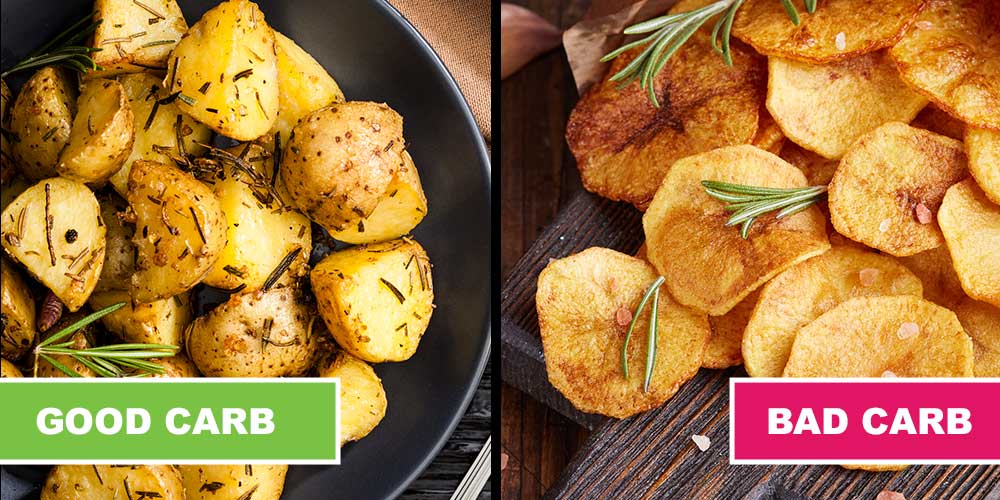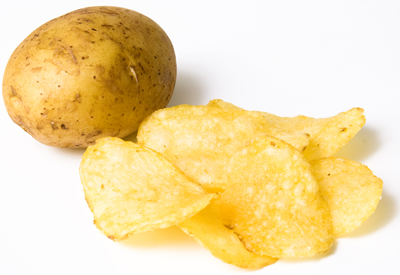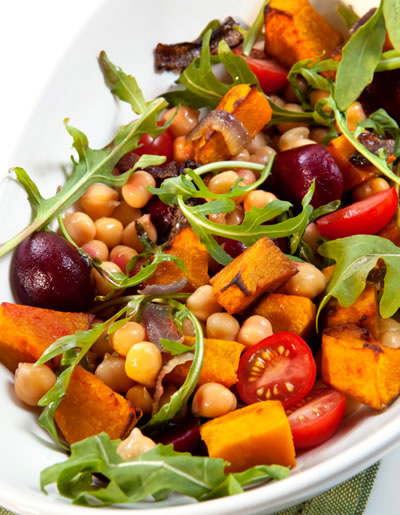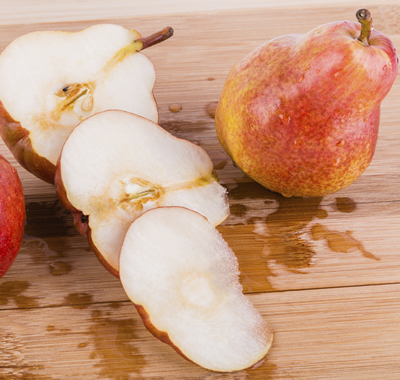What Are Good Carbs?
What Are Bad Carbs?
The first characteristic of a good carb is that it looks like something that actually came out of the ground. Potatoes are good carbs, not Pringles. Whole oranges are good carbs, not orange juice.

Good carbs are a fundamental part of the Pritikin Program of diet and exercise. The program has been documented in more than 100 peer-reviewed studies over the past three decades to reap multiple health benefits, including lowering of LDL (bad) cholesterol, normalizing of blood pressure, reducing blood sugar, and eliminating the need for major surgeries like coronary bypass surgery.
By following the 3 key traits of good carbs and making them the foundation of your daily diet, “you’ll naturally shed excess weight. You’ll also give yourself optimal protection again chronic conditions like heart attacks, stroke, type 2 diabetes, and high blood pressure,” says Kimberly Gomer, MS, RD, Director of Nutrition at the Pritikin Longevity Center.
Good carbs look as if they actually came out of the ground.
What Are Good Carbs? | #1
If you can pick a food from a garden, it is a good carbohydrate. For example, you can pick an apple, but you cannot pick apple juice.
You can find brown rice in a garden, but not rice crackers.

The one exception to this rule is whole-wheat pasta. Even though whole-wheat pasta is a processed food that cannot be found in a garden, it contains fiber, and it also absorbs water when cooked. So it contains the other 2 key characteristics of a good carb. (Keep reading.)
When you eat foods that came from the soil, you’re generally eating whole foods like fruits, vegetables, beans, and whole grains. Whole foods are packed with vitamins, minerals, phytochemicals, and other nutrients.
In fact, scientists now estimate there are more than 8,000 bioactive compounds in fruits and vegetables. And they are only now starting to understand how these compounds benefit us, both individually and in concert with each other.
Good carbs are naturally rich in fiber.
What Are Good Carbs? | #2
The word “naturally” is italicized because nowadays there are many foods on supermarket shelves that sound healthy, like “high-fiber” cereals and “high-fiber” energy bars. But what’s in many of these foods is not naturally occurring fiber. Through processing, any natural fiber has often been stripped out, and manufacturers have injected these foods with supplemental fiber.

The problem is: We don’t know if supplemental, or isolated, fiber has health benefits because the research we have on the health benefits of fiber-filled foods is based on foods naturally rich in fiber, not foods that have had fibers added to them.
Foods naturally brimming with fiber include:
- Whole Fruits
- Whole Vegetables
- Legumes (beans such as pinto beans, black beans, and garbanzo beans)
- Starchy Vegetables like potatoes, yams, and corn
- Cooked Whole Grains, such as oatmeal, brown rice, barley, whole-wheat pasta, spelt, bulgar, and quinoa
Foods high in naturally occurring fiber, like all the above, help reduce blood sugar and LDL cholesterol. They also help you fill up on fewer calories, so it’s easier to shed excess weight. You’re getting up from the table feeling full rather than hankering for more. A high-fiber diet also helps prevent constipation, hemorrhoids, and certain cancers.
Avoiding diabetes
In research on nearly 27,000 Europeans tracked for 11 years, those with the highest amount of fiber in their diet (26-plus grams a day) were nearly 20% less likely to develop type 2 diabetes than those with the lowest fiber intake (fewer than 19 grams a day).
The one thing that spurred weight loss and better health
And in another study on 240 U.S. men and women with a pre-diabetic condition called metabolic syndrome, researchers found that changing just one thing, the amount of fiber in their diet, helped the subjects lose weight and get significantly healthier.
They were directed to simply eat more whole foods naturally rich in fiber, such as fruits, vegetables, and whole grains, with the goal of reaching 30 grams of naturally-occurring fiber daily. That’s it. There was no calorie counting. No portion control. No pills or other diet aids. Nothing.
After one year, these high-fiber eaters not only lost weight, they lowered their cholesterol levels, blood sugar, blood pressure, and levels of inflammation.
“A simplified approach to weight reduction emphasizing only increased fiber intake may be a reasonable alternative for persons with difficulty adhering to more complicated diet regimens,” summed up the authors, from the University of Massachusetts Medical School.
Fiber goals
Americans average just 12 to 15 grams of fiber a day. Nutrition experts say we ought to be getting 35 to 50 fiber grams daily.
To get an estimate of how much naturally-occurring fiber you’re eating, use the following simple guidelines:
- Vegetables (1/2 cup cooked or 1 cup raw) = 2 to 3 grams of fiber
- Fruits (1 medium piece or 1/2 cup cut-up) = 2 to 3 grams of fiber
- Legumes/Beans (1/2 cup cooked) = 4 to 7 grams of fiber
- Starchy Vegetables (1/2 cup cooked) = 3 to 5 grams of fiber
- Cooked Whole Grains (1/2 cup cooked) = 3 to 5 grams of fiber
Good carbs are naturally rich in water.
What Are Good Carbs? | #3
Carbohydrates that are naturally rich in both fiber and water tend to be foods that have a low calorie density, “which is very good for your weight-loss goals,” advises Pritikin nutritionist Kimberly Gomer.

Low-calorie-dense foods are large in size but low in calories, meaning, they take up a lot of space on your plate (and in your stomach), but what you’re eating is not packed with calories. The fiber and water displace the calories.
So you’re eating foods that are filling, but not fattening.
Here’s a good example. Fresh fruit (very rich in water) averages only 300 calories for every pound eaten. Dried fruit (which has very little water) adds up to a waist-expanding 1,300 calories for every pound consumed.
Pasta, full of water, has 500 calories for every pound eaten. Bread (a dry food) packs in 1,250 calories per pound.
Oatmeal (like pasta, it’s cooked in water) has 300 calories per pound. Dry cereal has a whopping 1,700 calories for every pound eaten.
Quite often, water-rich foods are also rich in fiber and low in fat.
What Are Good Carbs? | Bottom Line
When the bulk of your diet is good carbs like fruits, vegetables, beans, starchy vegetables, and cooked whole grains, it’s virtually impossible to eat too many calories.
But you are getting a wealth of health-enhancing nutrients – vitamins, minerals, phytochemicals, and, yes, plenty of good naturally-occurring fiber.
For long-lasting weight control and good health, fill your day with good carbs.
Wellness Resort
Weight Loss Retreat
- Lower Cholesterol
- How Many Steps Should I Take to Lose Weight
- Smoothies for Weight Loss
- What Does High Cholesterol Mean
- What are The Benefits of Fish Oil
- Fitness Camps for Adults
- Healthy Food to Lose Weight
- Brown Bag Lunch Ideas
- Healthy Choices at Taco Bell
- Grocery List for Healthy Eating
- High Levels of Triglycerides